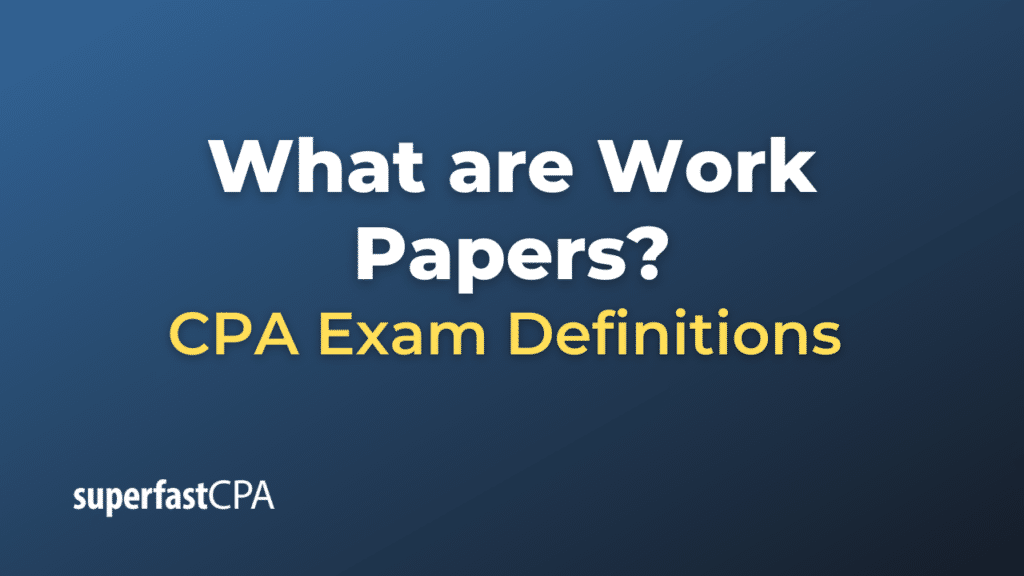Work Papers
Work papers, also known as working papers or audit working papers, are the documents that auditors create and maintain during the course of an audit to document the evidence, procedures, and rationale used to reach their conclusions. Work papers serve as the foundation for the audit and provide a record of the work performed, the results obtained, and the conclusions reached.
Purpose of Work Papers
- Documentation: Work papers serve as a record of the audit procedure followed, the tests performed, and the conclusions reached.
- Quality Control: They provide a basis for planning and conducting future audits by serving as a historical record.
- Review and Supervision: Work papers allow for the review of the audit by supervisors or external reviewers to ensure compliance with auditing standards and regulations.
- Legal Evidence: In case of legal disputes, work papers can serve as evidence to demonstrate that the audit was conducted in a thorough and reasonable manner.
Common Elements in Work Papers
- Title Page: A title page that includes the name of the entity being audited, the audit period, and the subject matter of the audit.
- Index: A table of contents or index to navigate the work papers easily.
- Purpose and Scope: A section outlining the purpose, scope, and objectives of the audit.
- Methodology: Detailed description of the audit methodology, including sampling techniques and analytical procedures used.
- Data and Evidence: All raw data collected during the audit, along with the evidence supporting the auditor’s conclusions.
- Calculations and Analyses: Spreadsheets, schedules, and other computations that support the audit findings.
- Correspondence: Letters, emails, and other communications related to the audit.
- Conclusions and Recommendations: The auditor’s final conclusions and any recommendations for improvement.
- Reviewer Notes: Comments and notes made by supervisory staff or peer reviewers.
- Attachments and Appendices: Any additional materials like contracts, invoices, or external reports that are relevant to the audit.
Importance of Work Papers
- Accountability: Work papers help maintain a level of accountability by documenting who performed the work, what was examined, and what conclusions were drawn.
- Professional Standards: Maintaining well-organized and comprehensive work papers is often a requirement under professional auditing standards, such as the Generally Accepted Auditing Standards (GAAS) in the United States.
- Efficiency: Work papers can make future audits more efficient by serving as a reference point for methodologies and findings.
Work papers are considered confidential and are not generally disclosed to third parties other than regulators or as required by law. Proper maintenance and storage of work papers are critical for both ongoing audit activities and potential legal requirements.
Example of Work Papers
Let’s imagine a simplified example to illustrate what work papers might look like for an internal audit conducted to assess the effectiveness of a company’s inventory management system.
Audit Work Papers: Inventory Management Audit
Company: XYZ Manufacturing Inc.
Audit Period: January 1, 2023, to March 31, 2023
Table of Contents
- Title Page
- Audit Plan
- Purpose and Scope
- Methodology
- Data and Evidence
- Calculations and Analyses
- Interviews and Correspondence
- Conclusions and Recommendations
- Reviewer Notes
- Appendices
1. Title Page
- Name of the Entity: XYZ Manufacturing Inc.
- Audit Subject: Inventory Management System
- Audit Period: Q1 2023
- Auditor: Jane Smith
2. Audit Plan
- Detailed plan outlining the audit’s timeline, major milestones, and resource allocation.
3. Purpose and Scope
- Purpose: To assess the effectiveness of the inventory management system.
- Scope: Includes all warehouses operated by XYZ Manufacturing Inc.
4. Methodology
- Sampling techniques used.
- Types of analytical procedures employed.
5. Data and Evidence
- Physical counts of inventory items.
- Observations made during site visits.
- System-generated inventory reports.
6. Calculations and Analyses
- Spreadsheet comparing physical counts with system records.
- Analysis of discrepancies and their financial impact.
7. Interviews and Correspondence
- Transcripts or summaries of interviews with warehouse managers and staff.
- Copies of email communications regarding inventory issues.
8. Conclusions and Recommendations
- Findings: e.g., The audit revealed discrepancies between physical counts and system records.
- Recommendations: e.g., Implement periodic reconciliations and update staff training.
9. Reviewer Notes
- Notes and comments from internal review or external quality assurance processes.
10. Appendices
- Any additional documents, such as supplier contracts, external audit reports, or photographs taken during site visits.
This example is a simplified representation and real-world work papers would be far more detailed and comprehensive. However, it should give you a general idea of what an auditor’s work papers might look like, including the types of information that would be documented and how the papers could be organized.













